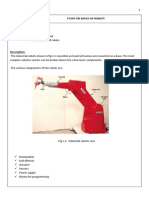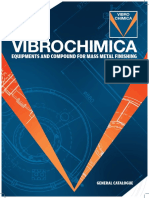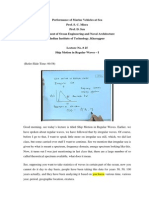0 ratings0% found this document useful (0 votes)
67 viewsClassification of Industrial Robots Work Volume Arm Configuration Advantages and Disadvantages of Robot Configurations
This document discusses different types of industrial robot configurations based on their arm configuration, power source, and path control. It describes Cartesian coordinate robots which move in orthogonal X, Y, and Z directions and have a rectangular working envelope. Cylindrical coordinate robots contain linear and rotational movement along a vertical column, approximating a cylindrical working volume. The advantages and disadvantages of each configuration and their common applications are also outlined.
Uploaded by
Anonymous kTVBUxrCopyright
© © All Rights Reserved
Available Formats
Download as PDF, TXT or read online on Scribd
0 ratings0% found this document useful (0 votes)
67 viewsClassification of Industrial Robots Work Volume Arm Configuration Advantages and Disadvantages of Robot Configurations
This document discusses different types of industrial robot configurations based on their arm configuration, power source, and path control. It describes Cartesian coordinate robots which move in orthogonal X, Y, and Z directions and have a rectangular working envelope. Cylindrical coordinate robots contain linear and rotational movement along a vertical column, approximating a cylindrical working volume. The advantages and disadvantages of each configuration and their common applications are also outlined.
Uploaded by
Anonymous kTVBUxrCopyright
© © All Rights Reserved
Available Formats
Download as PDF, TXT or read online on Scribd
You are on page 1/ 12
OVERVIEW
Classification of Industrial Robots
Work Volume
Arm Configuration
Advantages and Disadvantages of Robot Configurations
CLASSIFICATION OF ROBOTS
1. Based on Robot Arm Configuration
Cartesian coordinate
Cylindrical coordinate
Polar coordinate
Jointed arm configuration
2. Based on Power Source
Pneumatic
Hydraulic
Electric
3. Based on path control
Limited Sequence Robot
Point to point control
Path controlled Robot
WORK VOLUME
Work volume or work envelope refers to the space within which the robot can
manipulate its wrist end.
For defining the work volume, the wrist end convention is adopted to avoid the
complication of different sizes of end effectors that might be attached to the
robot’s wrist.
The work volume is determined by the following physical characteristics:
1. Robot’s physical configuration.
2. Sizes of the body, arm and wrist components.
3. Limits of robot’s joint movements.
ARM CONFIGURATION
Cartesian Coordinate System
• In this there are three orthogonal directions X,Y and Z.
• X-coordinate axis may represent left and right motion.
• Y-coordinate axis may represent forward and backward motion.
• Z-coordinate axis may represent up and down motions.
• Example of Cartesian System is Overhead Crane Movement.
Working Envelope of Cartesian Configuration Robot
The working envelope of the Cartesian configuration is a rectangular prism.
The robot can manipulate its maximum payload throughout the working volume.
Advantages:
Work envelope can be increased by travelling along the x axis.
Linear movement and hence simpler control.
High degree of accuracy and repeatability due to their structure.
Can carry heavier loads since load carrying capacity does not differ at different position
of the work envelope.
Disadvantages:
Movement is limited to only one direction at a time.
Applications:
Pick and place operation.
Adhesive applications.
Assembly and sub assembly.
Nuclear material handling.
Welding
Cylindrical Configuration Robot
• It uses a vertical column and a slide that can be moved up or down along the
column.
• The robot arm is attached to the slide so that it can be moved radially with respect
to the column.
• By rotating the column, the robot is capable of achieving a work space that
approximates a cylinder.
• It contains two linear motions and one rotational motion.
• Angular Motion, θ along vertical axis; Translation Motion, z along z-direction that
corresponds to up and down motion; Radial, r in or out translation.
Working Envelope of Cylindrical Configuration Robot
The working envelope of this configuration is as its name suggests a cylinder.
Advantages
Results in larger work volume than a rectangular manipulator.
Vertical structure conserves floor space.
Capable of carrying large payloads.
Disadvantages
Repeatability and accuracy are lower in the direction of rotary motion.
Requires more sophisticated control system.
Applications
Assembly.
Coating application
Die casting.
Foundry and forging application
Machine loading and unloading.
You might also like
- Robotics Mid 1 Answers: Explain The Classification of Robots by Coordinate System? I. Ans) Cartesian RobotsNo ratings yetRobotics Mid 1 Answers: Explain The Classification of Robots by Coordinate System? I. Ans) Cartesian Robots14 pages
- Introduction To Robot Technology - Dr. Janak ValakiNo ratings yetIntroduction To Robot Technology - Dr. Janak Valaki63 pages
- Unit-I: Robotics and Automation. This Includes "Dumb" Ro Woodworking Machines, "Intelligent" WashingNo ratings yetUnit-I: Robotics and Automation. This Includes "Dumb" Ro Woodworking Machines, "Intelligent" Washing27 pages
- Mechanism and Machine Theory: Ori Inbar, David ZarroukNo ratings yetMechanism and Machine Theory: Ori Inbar, David Zarrouk16 pages
- Planar Linkage Synthesis: A modern CAD based approachFrom EverandPlanar Linkage Synthesis: A modern CAD based approachNo ratings yet
- Industrial Robotics: Automation Beyond the PLC: Industrial Automation, #3From EverandIndustrial Robotics: Automation Beyond the PLC: Industrial Automation, #3No ratings yet
- Bounding Volume: Exploring Spatial Representation in Computer VisionFrom EverandBounding Volume: Exploring Spatial Representation in Computer VisionNo ratings yet
- What Is Research?: Concepts (Or Constructs) Are The Basic Building Blocks ofNo ratings yetWhat Is Research?: Concepts (Or Constructs) Are The Basic Building Blocks of2 pages
- What Is Research?: Concepts (Or Constructs) Are The Basic Building Blocks ofNo ratings yetWhat Is Research?: Concepts (Or Constructs) Are The Basic Building Blocks of2 pages
- Double Stage Reciprocating Air CompressorNo ratings yetDouble Stage Reciprocating Air Compressor1 page
- Classification of Industrial Robots Work Volume Arm Configuration Advantages and Disadvantages of Robot ConfigurationsNo ratings yetClassification of Industrial Robots Work Volume Arm Configuration Advantages and Disadvantages of Robot Configurations12 pages
- Systemic and Sustainable Change in Stem EducationNo ratings yetSystemic and Sustainable Change in Stem Education7 pages
- Self Assesment Questions (Topic-Wise) Physics Class XI (Board Level)No ratings yetSelf Assesment Questions (Topic-Wise) Physics Class XI (Board Level)215 pages
- CALDENTEY, C., J. A Mechanistic Model For Liquid Hydrocyclones (LHC)No ratings yetCALDENTEY, C., J. A Mechanistic Model For Liquid Hydrocyclones (LHC)109 pages
- Kinematics OF Machinery: Adithya Institute of TechnologyNo ratings yetKinematics OF Machinery: Adithya Institute of Technology34 pages
- The Motion of A Top: 1.1 Rolling Without FrictionNo ratings yetThe Motion of A Top: 1.1 Rolling Without Friction11 pages
- Inertia Forces Are In, or Nearly In, The Same Plane (1) - It Is Basically A Two-Dimensional IssueNo ratings yetInertia Forces Are In, or Nearly In, The Same Plane (1) - It Is Basically A Two-Dimensional Issue7 pages
- Compilation of Activities in Dynamics of Rigid Bodies: Technological Institute of The PhilippinesNo ratings yetCompilation of Activities in Dynamics of Rigid Bodies: Technological Institute of The Philippines5 pages
- 1S-PHY 101 - Physics Paper - I (Mechanics and Oscillations) : B.Sc. (With Credits) - Regular-Semester 2012 Sem INo ratings yet1S-PHY 101 - Physics Paper - I (Mechanics and Oscillations) : B.Sc. (With Credits) - Regular-Semester 2012 Sem I4 pages
- Experiment 5 - Rotational Inertia of Ring, Disk and DumbbellNo ratings yetExperiment 5 - Rotational Inertia of Ring, Disk and Dumbbell12 pages
- Regenerative Braking Control Strategy For Electric Vehicle With Four In-Wheel MotorsNo ratings yetRegenerative Braking Control Strategy For Electric Vehicle With Four In-Wheel Motors6 pages
- What Consists of A Gyroscopic Public Transport?: Future Towns & CitiesNo ratings yetWhat Consists of A Gyroscopic Public Transport?: Future Towns & Cities11 pages
- Dynamics of Machines Prof. Amitabha Ghosh Department of Mechanical Engineering Indian Institute of Technology, KanpurNo ratings yetDynamics of Machines Prof. Amitabha Ghosh Department of Mechanical Engineering Indian Institute of Technology, Kanpur17 pages
- Robotics Mid 1 Answers: Explain The Classification of Robots by Coordinate System? I. Ans) Cartesian RobotsRobotics Mid 1 Answers: Explain The Classification of Robots by Coordinate System? I. Ans) Cartesian Robots
- Introduction To Robot Technology - Dr. Janak ValakiIntroduction To Robot Technology - Dr. Janak Valaki
- Unit-I: Robotics and Automation. This Includes "Dumb" Ro Woodworking Machines, "Intelligent" WashingUnit-I: Robotics and Automation. This Includes "Dumb" Ro Woodworking Machines, "Intelligent" Washing
- Mechanism and Machine Theory: Ori Inbar, David ZarroukMechanism and Machine Theory: Ori Inbar, David Zarrouk
- Planar Linkage Synthesis: A modern CAD based approachFrom EverandPlanar Linkage Synthesis: A modern CAD based approach
- Industrial Robotics: Automation Beyond the PLC: Industrial Automation, #3From EverandIndustrial Robotics: Automation Beyond the PLC: Industrial Automation, #3
- Bounding Volume: Exploring Spatial Representation in Computer VisionFrom EverandBounding Volume: Exploring Spatial Representation in Computer Vision
- What Is Research?: Concepts (Or Constructs) Are The Basic Building Blocks ofWhat Is Research?: Concepts (Or Constructs) Are The Basic Building Blocks of
- What Is Research?: Concepts (Or Constructs) Are The Basic Building Blocks ofWhat Is Research?: Concepts (Or Constructs) Are The Basic Building Blocks of
- Classification of Industrial Robots Work Volume Arm Configuration Advantages and Disadvantages of Robot ConfigurationsClassification of Industrial Robots Work Volume Arm Configuration Advantages and Disadvantages of Robot Configurations
- Self Assesment Questions (Topic-Wise) Physics Class XI (Board Level)Self Assesment Questions (Topic-Wise) Physics Class XI (Board Level)
- CALDENTEY, C., J. A Mechanistic Model For Liquid Hydrocyclones (LHC)CALDENTEY, C., J. A Mechanistic Model For Liquid Hydrocyclones (LHC)
- Kinematics OF Machinery: Adithya Institute of TechnologyKinematics OF Machinery: Adithya Institute of Technology
- Inertia Forces Are In, or Nearly In, The Same Plane (1) - It Is Basically A Two-Dimensional IssueInertia Forces Are In, or Nearly In, The Same Plane (1) - It Is Basically A Two-Dimensional Issue
- Compilation of Activities in Dynamics of Rigid Bodies: Technological Institute of The PhilippinesCompilation of Activities in Dynamics of Rigid Bodies: Technological Institute of The Philippines
- 1S-PHY 101 - Physics Paper - I (Mechanics and Oscillations) : B.Sc. (With Credits) - Regular-Semester 2012 Sem I1S-PHY 101 - Physics Paper - I (Mechanics and Oscillations) : B.Sc. (With Credits) - Regular-Semester 2012 Sem I
- Experiment 5 - Rotational Inertia of Ring, Disk and DumbbellExperiment 5 - Rotational Inertia of Ring, Disk and Dumbbell
- Regenerative Braking Control Strategy For Electric Vehicle With Four In-Wheel MotorsRegenerative Braking Control Strategy For Electric Vehicle With Four In-Wheel Motors
- What Consists of A Gyroscopic Public Transport?: Future Towns & CitiesWhat Consists of A Gyroscopic Public Transport?: Future Towns & Cities
- Dynamics of Machines Prof. Amitabha Ghosh Department of Mechanical Engineering Indian Institute of Technology, KanpurDynamics of Machines Prof. Amitabha Ghosh Department of Mechanical Engineering Indian Institute of Technology, Kanpur





































































































